EIA: Environmental Impact Assessment Examples, Methods & Steps
When a project, policy change, or event has a chance of impacting any part of an environment or ecosystem, it’s important to do an environmental impact assessment (EIA).
Not only is an EIA screening the responsible way to proceed with a project or plan, but it’s also often required by law to ensure that human interventions won’t cause undue harm or irreversible damage to the environment.
An environmental impact assessment example would be the need to assess what a new manufacturing facility in a region means as far as air quality, water quality, noise pollution, ecosystem upset, and more.
The impact of EIA reports on a project or planned policy change can include:
- A project/policy being abandoned because of the potential for negative environmental impact
- The scoping in EIA identifying alternative ways to proceed to mitigate negative impacts
- A project being delayed while EIA tools are used to mitigate impact issues

What EIA Means? | Environmental Impact Assessment Example
In this AGS introduction to EIA, we’re going to review the purpose of an environmental impact assessment and the types of EIA reports that you may run across.
Other topics this EIA assessment article will cover are:
- The need for environmental impact assessment
- EIA environmental impact assessment meaning
- The benefit of environmental impact assessment
- Environmental impact assessment methodologies
- Scoping in environmental impact assessment
- Problems of environmental impact assessment to overcome
- Environmental impact assessment checklist template (EIA PPT)
Read on to learn all about environmental impact assessment benefits, methodologies, what EIA matrixes are, and EIA processes.
See Also: All You Need to Know About Change Impact Assessment
What Is Environmental Impact Assessment? (What EIA Means?)
Environmental impact assessment, including EIA processes, is the identification and analysis of any impact that a project, program, or proposed policy change may have on the environment.
An environmental impact assessment project will look for effects, both positive and negative, on things like air and climate, land, water, ecology and biodiversity, and human environment.
The need for EIA assessment is evidenced by the wide variety of global environmental rules and regulations governing projects, legislation, or other changes that can cause an effect on the environment.
EIA software templates and tools are used to make the environmental impact analysis easier to manage and ensure no important areas of scoping in EIA are left out.
The results of an environmental impact assessment examples report will detail the types of environmental impacts expected from a project or policy change. It will also provide recommendations for alternative options and methods to mitigate negative impacts.
In most jurisdictions in the U.S., as well as many other countries, the benefit of EIA is well established, and projects or policy changes that have a chance of environmental impact are required to perform one of several types of environmental impact assessment.
Even though there can be challenges of environmental impact assessment in developing countries due to the lack of regulations and government infrastructure for monitoring, the positive impact of EIA is still widely recognized.
When Did the Concept of Environmental Impact Assessment Begin?
Informally, the need for EIA first started to be seen in the U.S. in the 1960s. This was right before the big environmental push in the 1970s for environmental sustainability and reduction of pollution.
An introduction to EIA by industry then later resulted in the government formalizing the need for environmental impact assessment in 1969. This is when the National Environmental Policy Act (NEPA) was enacted.

Don’t Miss: PIA/PII Privacy Impact Assessment | Everything You Need to Know
What is the Requirement for Environmental Assessment NEPA?
Federal agencies are the entities impacted by the environmental assessment NEPA regulation. Whenever an agency develops a proposal to take any major federal action, it must adhere to the NEPA EIA processes.
The environmental assessment NEPA review encompasses three levels of environmental impact analysis. Each of these types of EIA levels is designed to ensure a potential impact is reviewed thoroughly.
The levels of the environmental assessment NEPA process are:
- Categorial Exclusive (CATEX): The categorical exclusion from a detailed ecological impact assessment may be granted if the federal action being taken does not typically have a significant environmental impact.
- Environmental Assessment (EA): This is prepared by an agency to determine whether or not an action can potentially cause significant environmental impacts.
- Environmental Impact Statement (EIS): The EIS is the same as the concept of environmental impact assessment. It contains the same details, including the type of impact expected, mitigation recommendations, and monitoring plans.
What is the Importance of Environmental Impact Assessment?
Without the use of an environmental impact assessment matrix to list out all potential impacts of a project, new regulation, or policy change on the environment, both humans and the ecosystem could be harmed.
If you’re reading the benefits of environmental impact assessment PPT or PDF guide related to environmental impact assessment methods for government and businesses, you’ll find some of the following described as a benefit of EIA:
- Preserves cultural, historical, and natural heritage
- Enhances renewable resources
- Prioritizes harmony between man and nature
- Mitigates unintended environmental consequences of projects/policies
- Protects environmental resources for future generations
- Keeps environment livable
What is the Benefit of EIA?
Environmental impact assessment benefits can range from protecting a heritage site to preventing the contamination of drinking water for a community. Despite the challenges of environmental impact assessment in developing countries, the results can mean the difference between life or death.
For example, in an underdeveloped community with rich natural resources, environmental impact assessment meaning can be the halt of a project that would ruin farmland and thus the community’s ability to thrive.
Environmental impact assessment project requirements are often legal ones. For example, the EIA assessment may need to be done for a building permit to be granted for a large construction project.
Environmental impact assessment methodologies are also designed to provide educational information that connects action with environmental repercussions. This can inform how a project or policy proceeds and helps shed a light on more environmentally friendly alternatives that can potentially be implemented.
Scoping in environmental impact assessment is vital on a grand scale to keep our planet and environment inhabitable for future generations.

What EIA is Best? | Environmental Impact Assessment Examples
Related: Best Economic Impact Analysis

What Are the Types of Environmental Impact Assessment?
An environmental impact assessment template can be categorized as needed. One of the problems of environmental impact assessment can be when there is no structured framework. In this case, the tools of EIA can lead to a subjective analysis that is not backed up by any quantitative means.
EIA tools that allow you to designate specific data inputs help to ensure that consistent metrics are used for all EIAs.
There are four types of environmental impact assessments. If you’re wondering what EIA to use, the types are EIA and their descriptions are as follows.
Strategic EIA
The strategic EIA (SEIA) is performed when there are still several alternatives open for a project. What EIA is designed to do in this case is to be a proactive part of the planning process for a new project, program, or policy.
The benefits of environmental impact assessment PPT SEIA early in the development stages and decision-making process can include reducing the cost of potential rework needed. For example, if a project has already been planned in detail before the EIA environmental impact assessment is performed, it could need expensive alterations because of the impact of EIA findings.
Regional EIA
The regional EIA, environmental impact assessment, is the most common. The only way it differs from the strategic EIA in scope is that it’s usually done after the main project or policy planning has taken place and is the next step in the process before finalizing project details.
The environmental impact assessment matrix will include a specific region of study that is expected to be impacted by the project, policy, or regulation change.
The specific region that is the focus of an environmental impact assessment example may be a country, several counties or provinces, one county, a city, or a neighborhood. The region for the EIA screening will be decided based upon the expected reach of the impacts.
Sectorial EIA
Within the scoping in EIA for a regional assessment can be the sectorial EIA. This will typically focus on a specific area of impact, such as air or water quality.
A sectorial EIA is typically done to identify the varying levels of impact on different sectors (human health, coastal and marine ecosystem, etc.). This type of ecological impact assessment can then be combined with other sectorial EIAs for a detailed regional EIA assessment.
Project Level EIA
A project-level EIA has a smaller regional scope and the environmental impact assessment methods are looking just at developmental activity impacts on the receiving area of a project.
It doesn’t typically include impacts on a larger region or cumulative impacts that may occur.
What Should Be Included in an Environmental Impact Assessment?
An EIA PPT guide and impact assessment template can be very helpful to ensure you have all required data accounted for when working on an environmental impact assessment project.
On a grand scale, the scoping in environmental impact assessment should be done to include all impacts that a project, program, or policy will have on the environment of a specific region or area.
There are several environmental impact assessment methodologies for expressing those impacts, which we’ll get into in the next section. These will include using both quantitative and qualitative methods of explaining the types of environmental impact assessment and their results.
An environmental impact assessment example will generally categorize impacts as:
- Air and Climate: This includes things like air quality, health implications, ecosystem impacts, contributions to climate change, etc.
- Land: This includes the use of non-renewable resources, changes to land morphology, impacts to historic or cultural sites, etc.
- Water: This includes impacts on local drinking water, sustainability, the effect of local use for irrigation and other activities, health implications, etc.
- Ecology & Biodiversity: This includes the importance of biodiversity value, both terrestrial and marine, economic use to the community, ecosystem well-being, etc.
- Human Environment: This includes things like light and noise pollution, community safety, employment opportunities, community value creation, etc.
These impacts will be at the center of the alternative recommendations and suggested mitigations for negative impacts, which makes them the vital driver that illustrates the environmental impact assessment benefits. The rest of the report is generated based upon these impacts.
How Do You Format Environmental Impact Assessment Reports?
Using an environmental impact assessment checklist template can help when it comes to gathering information for an EIA assessment (you’ll find one further down this page). This will give you a data gathering guide you can follow when a project requires environmental impact assessment.
Once you’ve gathered the necessary information, you need to format it into a comprehensive report, including data, projections, charts, and more.
While those that need no introduction to EIA may have their own methods of formatting the assessment report, we have included a general format below that you can reference.
- Introduction
- Introduction to EIA
- Benefit of environmental impact assessment
- Summary of team conducting EIA screening
- Summary of Project
- Project description
- Description of environmental impact assessment methodologies used
- Summary of environmental categories assessed (air, land, etc.)
- Any pertinent policies and/or regulations related to need of EIA
- Description of Site & Surroundings
- Boundary descriptions assessed area
- Existing land-use patterns
- Demographics (population, employment statistics, etc.)
- Baseline data on existing soil profiles, air quality, ecology
- Environmental Effects of Proposed Project/Policy
- Qualitative details related to the anticipated impacts on the environment (positive & negative)
- Direct/indirect impacts
- Permanent/reversible impacts
- Cumulative impacts
- Evaluation/Analysis Detail
- Quantitative evaluation with data on projected impacts
- Use of environmental impact assessment matrix
- Environmental Management Plan
- Proposed actions to mitigate negative impacts
- Implementation schedule
- Estimated budget
- Issues/environmental consequences
- Alternatives
- Alternative project/policy options to reduce environmental impact
- Comparison of alternatives
- Description of Proposed Monitoring Program
Environmental Impact Assessment Methods
Before we dive into the different types of environmental impact assessment methods used, let’s discuss why using this type of framework is important.
There has been criticism and questioning of environmental impact assessment meaning because of the lack of a standardized procedure for conducting impact assessments.
Some have said that while the concept of environmental impact assessment is a good one, the implementation isn’t always carried out objectively and can be too subjective in some cases.
The lack of a standardized environmental impact analysis framework has been noted as one of the challenges of environmental impact assessment in developing countries.
EIA tools that apply a methodology to scoping in EIA have been developed to help resolve this problem and bring a consistent structure of best practices to all types of EIA assessment.
Some of the problems of environmental impact assessment that the use of EIA assessment methods and frameworks is designed to resolve include:
- Lack of consistent tools of EIA reporting
- Differing levels of environmental impact assessment examples
- The impact of EIA being poor due to lack of objective data
- Steep learning curve for those starting an introduction to EIA
- Lack of framework for creating a good environmental impact assessment tool
Following are four popular environmental impact assessment methodologies:
Network Method
The network method for ecological impact assessment uses a visual flow chart that directly connects an impact to an action. It can also capture secondary, or indirect, impacts, and makes it easy to see multiple impact areas for a single action.
An advantage of the network method is that it works nicely with any benefits of environmental impact assessment PPT you may be using due to it providing a visual snapshot of the cause-effect linkages.

This type of flowchart format also allows you to add as much detail as you like to the diagram area for each impact, including quantitative data to back up impact projections.
However, if you have a large project with multiple impacts and impact areas to chart, the network method can become too confusing as you branch out multiple impact trees.
Leopold Matrix Method
The Leopold environmental impact assessment matrix was developed in 1971 as a way to connect the environmental factors to be considered for impact during each stage of a project. This is one of the qualitative EIA processes and it includes a grading scale for two factors of the potential impact.
The Leopold matrix is set up with the factors of environmental importance as rows (Land, Biodiversity, Human Environment, etc.) and the stages of the project as columns (excavation of land, construction, waste generation, etc.).
For each intersecting impact cell, a grade is given to two factors:
- Magnitude of the impact (scale of -10 to +10)
- Importance of impact to the project (scale of 1 to 10)
Magnitude can include how much of an impact an event will have on that specific ecological area. The importance of impact relates to how important that impact is to the entire project as a whole.
An event could have a high magnitude of impact on one specific environmental area but have a low importance to the project overall.
The Leopold matrix illustrates the benefit of EIA to zero in on specific areas of ecological impact that will need the most attention, for example, those with high importance and high magnitude of impact.
Battelle Method
The Battelle Environmental Evaluation System (BEES) was developed in 1972 by Battelle Columbus Laboratories. This is one of the environmental impact assessment methods designed to incorporate quantitative measurement.
Projects in need of EIA analysis that is more detailed and that incorporates weighing and aggregating impacts will benefit from this method. It can however be difficult for those new to an environmental impact assessment project to grasp, and they may find it less flexible than other methods.
What EIA you choose to use will often depend upon the stakeholders involved and the level of detail needed. The Battelle method is very detailed, which may be a benefit of environmental impact assessment sought in certain large projects.
This method uses several levels of data:
- Level 1: Four categories of human concern (Ecology, Physical/Chemical, Aesthetics, Human Interest)
Level 2: A breakdown of 18 components of each Level 1 category - Level 3: A further breakdown into 78 parameters of Level 2 components
- Level 4 – 6: Parameter Importance Unit (PIU) measurements for each of the other levels on the environmental impact, using a conversion of different measurements in common units and aggregating results within the levels.
Rapid Impact Assessment Matrix (RIAM)
Developed in 1998, the Rapid Impact Assessment Matrix (RIAM) is one of the EIA processes that presents a holistic view of impacts in a semi-qualitative system. You’ll see that this method is somewhat of a cross between the Leopold Matrix and the Battelle method.
This environmental impact assessment example model evaluates four groups of environmental elements, which are:
- Physical/chemical
- Biological/ecological
- Social/cultural
- Economic/operational
Each of these four groups is assessed according to five different characteristics of impacts and each uses a scale to designate a value.
These characteristics are:
A1: Importance of Condition
4: International Importance
3: National Importance
2: Outside of Local Condition
1: Local Condition
0: Not Important
A1: Magnitude of Change-Effect
+3: Major Positive Benefit
+2: Significant Improvement
+1: Improvement in “Status Quo”
0: No change
-1: Negative Change to “Status Quo”
-2: Significant Negative Effect
-3: Major Negative Effect
B1: Permanence
1: No Change/Not Applicable
2: Reversible
3: Irreversible
B2: Reversibility
1: No Change/Not Applicable
2: Reversible
3: Irreversible
B3: Cumulative
1: No Change/Not Applicable
2: Non-Cumulative/Single
3: Cumulative/Synergistic
Each of the above scores is then expressed in a formula:
- A1 and A2 are multiplied to return a result (aT)
- B1, B2, B3 are added together to return a result (bT)
An Environmental Classification is then provided using: (aT) * (bT) = ES (1). This environmental score relates to an overall description class that ranges from “Extremely positive impact” at the top to “Extremely negative impact” at the bottom.

Popular Article: All You Need to Know About Social Impact Assessment (SIA)
EIA Processes & Steps
Now that you know the scope of information included in an EIA environmental impact assessment and four different types of EIA methods you can use to gather and score impacts, let’s look at the reporting steps.
These EIA processes will typically begin when there is an indication in the early stages of project development or proposed policy change that there will be some type of impact on the environment as a result.
EIA Screening
EIA screening will be done in the early project/policy planning stage to determine whether or not an EIA environmental impact assessment is needed. Local and regional regulations may also be researched at this time to see what EIA requirements a project may fall under.
During the screening, if it is determined that the impact of EIA reporting is required, the level of depth and scope of the assessment will be determined.
The EIA screening process sheds light on any potential environmental impact of a project or policy change and can then inform how the project is planned from there.
EIA Scoping
Once the need for environmental impact assessment has been affirmed, the next stage is scoping.
The main bulk of the work of the EIA processes happens during scoping in EIA. This is when all data is being gathered (through research, statistics, surveys, etc.), the chosen environmental impact assessment template is being used, and the EIA methodology is being followed.
Scoping in environmental impact assessment includes:
- Identification of potential impacts on environmental areas
- Detail of the level/quantification of the impact
- Development of mitigation solutions for negative impacts
Development of Alternatives & Monitoring Recommendations
When negative impacts are identified using EIA tools and processes, the next step is to develop potential alternatives to the events causing those negative impacts. These are then presented in the EIA report.
An environmental impact assessment example of an alternative would be if a sandblasting and solvent-based painting activity for a project was expected to have a harmful impact on a nearby water supply. An alternative might be suggested to use dustless sandblasting and an eco-friendly, water-based paint instead.
A monitoring plan should also be developed for observing the actual impacts from the project to see if they match what was expected. Monitoring can also identify any negative environmental impacts that happen, which were not anticipated.
Environmental Impact Statement (EIS)/EIA Report
Next, all the data collected during scoping in EIA is collated and presented in the EIA report, which is also referred to as an Environmental Impact Statement (EIS). This will inform project stakeholders on what impacts are expected and what options are available to mitigate any negative impacts.
This report can be presented in an EIA PPT or a full, multi-page report, depending on the needs of the project and stakeholders. We’ve detailed earlier in this article what is typically included in an EIA environmental impact assessment report.
Review of the EIA Report/EIS
The impact of EIA reporting is now taken to the decision-making level where the report will be reviewed and decisions made about project value, efficacy based upon the EIA report, and whether to approve the report recommendations and move forward.
Monitoring and Environmental Auditing
The monitoring plan is implemented during and after the project completion or policy implementation. The goal is to identify any unexpected impacts, evaluate whether predicted impacts and proposed mitigation occurs as outlined, and address any new potential problems that arise.

Read More: Benefits of Organizational Change Management
Environmental Impact Assessment Checklist Template – EIA PPT
Have you been studying environmental impact assessment examples to see what needs to be done for your own EIA? An environmental impact assessment checklist template can help ensure you don’t leave out any important data.
Our free downloadable EIA PPT and PDF checklists guide you in gathering the baseline data that you need during the EIA processes where you are showing impact levels against the “status quo.”
What EIA data needs to be gathered on each environmental area? This environmental impact assessment example will lay it out for you in a checklist format.
You can download our EIA PPT and PDF checklist below.

Download EIA PPT – Environmental Impact Analysis Checklist
Download EIA PDF – Environmental Impact Analysis Checklist

Conclusion | #1 Guide to EIA Screening & Environmental Impact Analysis
The world would be a much less livable place if it weren’t for EIA screening and the work of those conducting EIA environmental impact assessments.
It’s important to understand the full scope of potential impacts that a project, plan, or new policy may cause to the environment so efforts can be made to reduce negative effects and maximize a “win-win” situation for both the project and the community being impacted.
Ecological impact assessment strives to create harmony in an environment and mitigate negative outcomes. The positive results when a plan is f0llowed, illustrate the benefit of EIA reporting.
There are several methods to consider when deciding what EIA assessment approach to use, from those that are purely qualitative to the more quantitative models that try to weight each factor and aggregate cumulative impacts.
It’s important to go into scoping in EIA with a plan, including a checklist of environmental areas to assess and EIA tools and templates that can make the data collection, analysis, and reporting streamlined and more efficient.
Impact of EIA Environmental Impact Analysis FAQ
What is EIA?
Environmental impact assessment (EIA) is the identification and analysis of any impact that a project, program, or proposed policy change may have on the environment.
An environmental impact assessment project will look for effects, both positive and negative, on things like air and climate, land, water, ecology and biodiversity, and human environment.
What is the importance of environmental impact assessment?
Without the use of an environmental impact assessment matrix to list out all potential impacts of a project, new regulation, or policy change on the environment, both humans and the ecosystem could be harmed.
The benefit of environmental impact assessment includes:
• Preserves cultural, historical, and natural heritage
• Enhances renewable resources
• Prioritizes harmony between man and nature
• Mitigates unintended environmental consequences of projects/policies
• Protects environmental resources for future generations
• Keeps environment livable
What are the types of environmental impact assessment?
There are four key types of environmental impact assessment. These are as follows.
Strategic EIA
The strategic EIA (SEIA) is performed early in project planning when there are still several alternatives open for a project.
Regional EIA
The regional EIA, environmental impact assessment, is the most common. It’s usually done after the main project or policy planning has taken place.
Sectorial EIA
This will typically focus on a specific area of impact, such as air or water quality. Several sectorial EIAs can be compiled into a full report.
Project Level EIA
A project level EIA has a smaller regional scope.
What should be included in an environmental impact assessment?
An environmental impact assessment should include details on baseline conditions, expected impacts, mitigation recommendations, and potential alternatives for impacts on the following environmental areas:
• Air and Climate
• Land
• Water
• Ecology & Biodiversity
• Human Environment
Note: Content on OCM Solution's ocmsolution.com website is protected by copyright. Should you have any questions or comments regarding this OCM Solution page, please reach out to Ogbe Airiodion (Change Management Lead) or the OCM Solution Team today. OCM Solution was previously known as Airiodion Global Services (AGS).
Images: https://pixabay.com/photos/environmental-protection-nature-3341942/, Microsoft 365 Clip Art Image(s) (Bing images licensed under the Creative Commons license system.), https://www.ls.graphics/free/free-pixel-4-and-pixelbook-go-mockup

